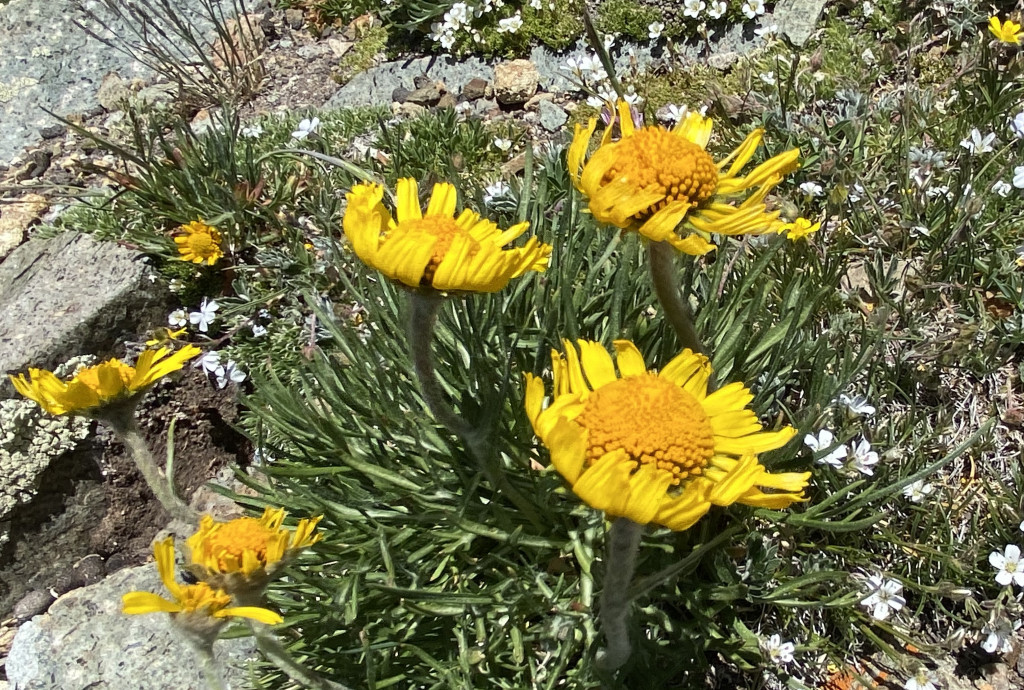Life in the Alpine Tundra

COLORADO MOUNTAINS — Look east from the floor of the San Luis Valley and the stunning Sangre de Cristo Mountain range tower above us with incredible majesty. Further east are the Culebras and the Spanish Peaks. From a distance, you can see where the trees end, and the alpine tundra begins. From afar, it may look barren, yet living organisms of all kinds have found a way to flourish. It is August and the perfect time to head up into those mountains to explore, so let's journey up high.
As we move through the forest, the atmospheric pressure drops with less oxygen available to breathe, so we slow down and breathe faster. Extra jackets keep the shivers at bay as the temperatures drop, and the wind picks up. Sunglasses and hats reduce the increased light radiation.
Just as humans reach for jackets, hats, and sunglasses for protection, living wild organisms also adapt to the change. Plants become tiny and hug the ground to avoid the wind, leaves become waxy and succulent avoiding light radiation, and others grow hair for insulation.
The Alpine sunflower is a native here stems and leaves are covered with soft silvery-white woolly hairs. The short growing season that retards root growth will contribute to the 15-20 years it will take for this sunflower to bloom. Unlike many other sunflowers, the flower heads typically face east and do not turn with the sun; this may be an adaptation to avoiding damage from violent afternoon thunderstorms, from the west.
Roots become more robust to store nutrients, trees become gnarled and small from the extreme cold and wind, insects fly more slowly, many mammals hibernate for most of the year, and fur colors change for camouflage. And as we climb, the forest trees begin to change. The mighty Ponderosa Pine and stately blue sprue give way to better-adapted tree species living in even harsher conditions at higher elevations. Towering dense forests of Engelmann spruce and subalpine fir trees create a feeling of mystery and hidden secrets. Gnarled old, twisted bristlecone and limber pines appear. These pines can grow to nearly 1,500 years old here in Colorado, and even twice that age in the high mountains of California. As we continue to walk higher, the temperature change and unavailable oxygen is noticeable; deep satisfying breaths are more difficult to acquire. Winter here is long and cold, and the snow can linger into the summer months. The chance of snow and frost is constant, and poses a continual challenge for plants, birds, mammals, and insects. Ocean spray, raspberry, wild rose, golden-banner, lupine, skunk cabbage, sugar-bowls, and tiny monkey flowers flourish within the forest and out among the grassy openings. Now, we step above the treeline and observe life exploding into a million tiny details of incredible adaptations within one of the harshest ecosystems on the planet — the alpine tundra.
In their classic book, “Life Above the Trees,” Ann Zwinger and Beatrice Willard wrote this, "The alpine tundra is a land of contrast and incredible intensity, where the sky is the size of forever, and the flowers the size of a millisecond."
This is a place with even more intense wind, cold, ultraviolet radiation, and a growing season of only 6-10 weeks. That means nothing grows here for 80% of the entire year. Plants hug tight to the ground and grow only inches high to avoid the harsh conditions. Leaves are thick, waxy, and hairy with red or blue pigments called anthocyanins which convert light to heat. The robust roots are often the largest portion of alpine plants and can extend into the soil for several feet. Relative to lower elevations, life cycles and soil formation are extremely slow. Patience is truly a virtue here, as it takes one thousand years for a single inch of soil to form, and up to 10 years for certain plants to form flowers. Pick a flower and you have just destroyed years and years of seed development, trample on soil, and in an instant thousands of years of decomposition is gone. Move deliberately with slow defined steps, bend in close, and observe all the tiny cushion plants hugging the ground.
You will find Moss campion, Cushion phlox, Alpine Spring Beauty, Stonecrop, Alpine sunflower, Rocky Mountain lousewort-Rocky Mountain sky pilot, Rocky Mountain columbine, and many more.
The Alpine sunflower is a native here and stems and leaves are covered with soft silvery-white woolly hairs. The short growing season that retards root growth will be instrumental in the 15-20 years it will take for this sunflower to bloom. Unlike many other sunflowers, the flower heads typically face east and do not turn with the sun; this may be an adaptation to avoiding damage from violent afternoon thunderstorms, from the west.
When you stand and focus your view to the distance in the west toward the San Luis Valley, you breathe in and appreciate the alpine tundra in all of its glory. Experience the vastness of this place and all of the amazing adaptations that allow life here to survive.
The Colorado Rare Plant Symposium will be held on the campus of Adams State University in Alamosa on Sept. 22, and the Colorado Native Plant Society will have its annual meeting on the ASU campus on Sept. 23-24. For more information, visit www.conps.org.



